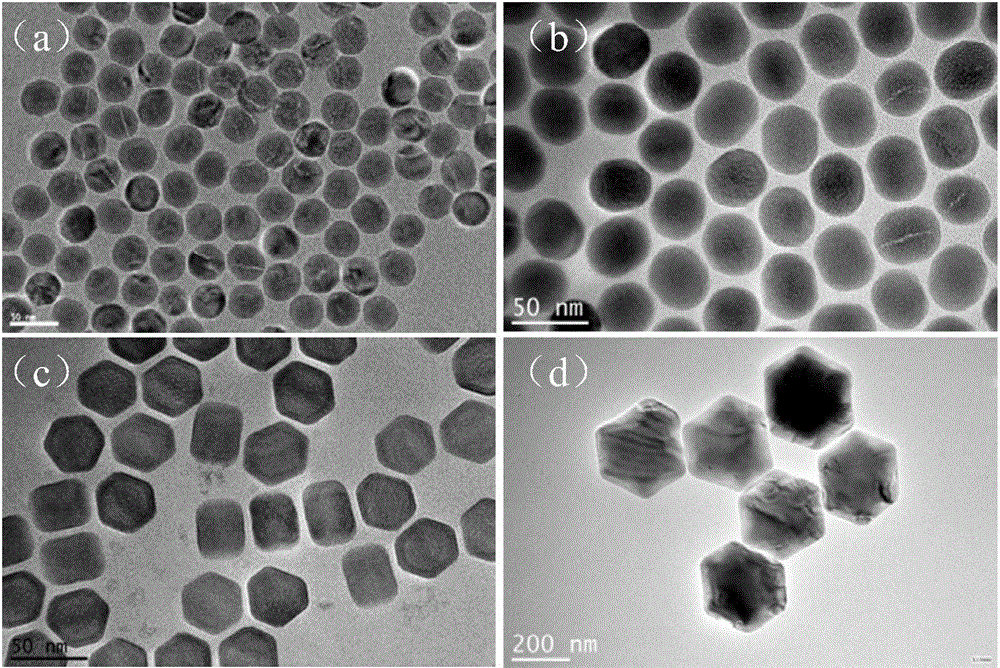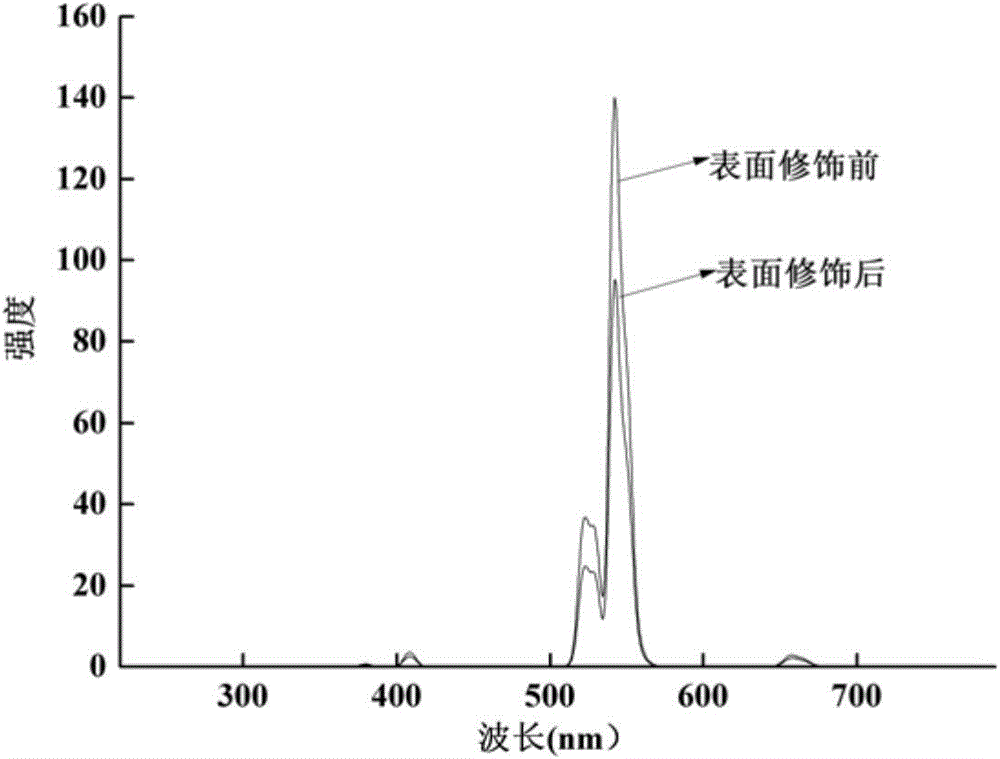Surface modification method of oil-soluble upconversion luminescent nanometer material
A fluorescent nanomaterial and surface modification technology, which is applied in the field of surface modification to improve the water solubility of oil-soluble rare earth up-conversion fluorescent nanomaterials, can solve the problems of affecting the fluorescence of materials, instability, generation of impurity materials, etc., and achieves low cytotoxicity and good cytotoxicity. Water-soluble, low biocompatibility effect
- Summary
- Abstract
- Description
- Claims
- Application Information
AI Technical Summary
Problems solved by technology
Method used
Image
Examples
Embodiment 1
[0056] In this embodiment, the surface modification of oil-soluble up-conversion fluorescent nanomaterials is carried out according to the following steps:
[0057] a. Weigh 80mg NaYF 4 :Yb,Er,NdNaYF 4 : Nd (40nm) oil-soluble up-conversion fluorescent nanomaterial with core-shell structure is placed in a flask, and 3 mL of chloroform is added to disperse evenly to obtain solution A;
[0058] b. Add 10 mg mPEG to Solution A 2K -b-PEBEP 6K , stirred for 0.5h to obtain reaction solution B;
[0059] c. Add 40mL of deionized water to the reaction solution B, and stir for 0.5h to obtain the reaction solution C;
[0060] d. At 20°C, remove the chloroform in the reaction solution C to obtain the reaction solution D;
[0061] e. The reaction solution D was centrifuged at 10000 rpm for 10 min, and the obtained precipitate was dried, that is, the surface modification of the oil-soluble up-conversion fluorescent nanomaterial was completed, and the water-soluble up-conversion fluoresc...
Embodiment 2
[0067] In this embodiment, the surface modification of oily upconversion nanoparticles is carried out according to the following steps:
[0068] a. Weigh 169mg NaYF 4 : Yb, Er (18nm) oil-soluble up-conversion nanoparticles in a flask, add 10mL of chloroform, and disperse evenly to obtain solution A;
[0069] b. Add 10 mg mPEG to Solution A 2K -b-PEBEP 6K , stirred for 1h to obtain reaction solution B;
[0070] c. Add 100 mL of deionized water to the reaction solution B, and stir for 2 hours to obtain the reaction solution C;
[0071] d. At 40°C, remove the chloroform in the reaction solution C to obtain the reaction solution D;
[0072] e. The reaction solution D was centrifuged at 14600 rpm for 20 minutes, and the obtained precipitate was dried, that is, the surface modification of the oil-soluble up-conversion fluorescent nanomaterial was completed, and the water-soluble up-conversion fluorescent nanomaterial was obtained.
[0073] Characterized by a fluorescence spectr...
Embodiment 3
[0075] In this embodiment, the surface modification of oily upconversion nanoparticles is carried out according to the following steps:
[0076] a. Weigh 60mg NaYF 4 : Yb, Er, Nd (34nm) oil-soluble up-conversion nanoparticles in a flask, add 4mL cyclohexane, uniformly dispersed, to obtain solution A;
[0077] b. Add 10 mg mPEG to Solution A 2K -b-PEBEP 6K , stirred for 1h to obtain reaction solution B;
[0078] c. Add 60 mL of deionized water to the reaction solution B, and stir for 2 hours to obtain the reaction solution C;
[0079] d. At 40°C, remove the cyclohexane in the reaction solution C to obtain the reaction solution D;
[0080] e. The reaction solution D was centrifuged at 12000 rpm for 10 min, and the obtained precipitate was dried, that is, the surface modification of the oil-soluble up-conversion fluorescent nanomaterial was completed, and the water-soluble up-conversion fluorescent nanomaterial was obtained.
[0081] Characterized by the fluorescence spectro...
PUM
| Property | Measurement | Unit |
|---|---|---|
| diameter | aaaaa | aaaaa |
| particle diameter | aaaaa | aaaaa |
| particle diameter | aaaaa | aaaaa |
Abstract
Description
Claims
Application Information
 Login to View More
Login to View More - R&D
- Intellectual Property
- Life Sciences
- Materials
- Tech Scout
- Unparalleled Data Quality
- Higher Quality Content
- 60% Fewer Hallucinations
Browse by: Latest US Patents, China's latest patents, Technical Efficacy Thesaurus, Application Domain, Technology Topic, Popular Technical Reports.
© 2025 PatSnap. All rights reserved.Legal|Privacy policy|Modern Slavery Act Transparency Statement|Sitemap|About US| Contact US: help@patsnap.com



